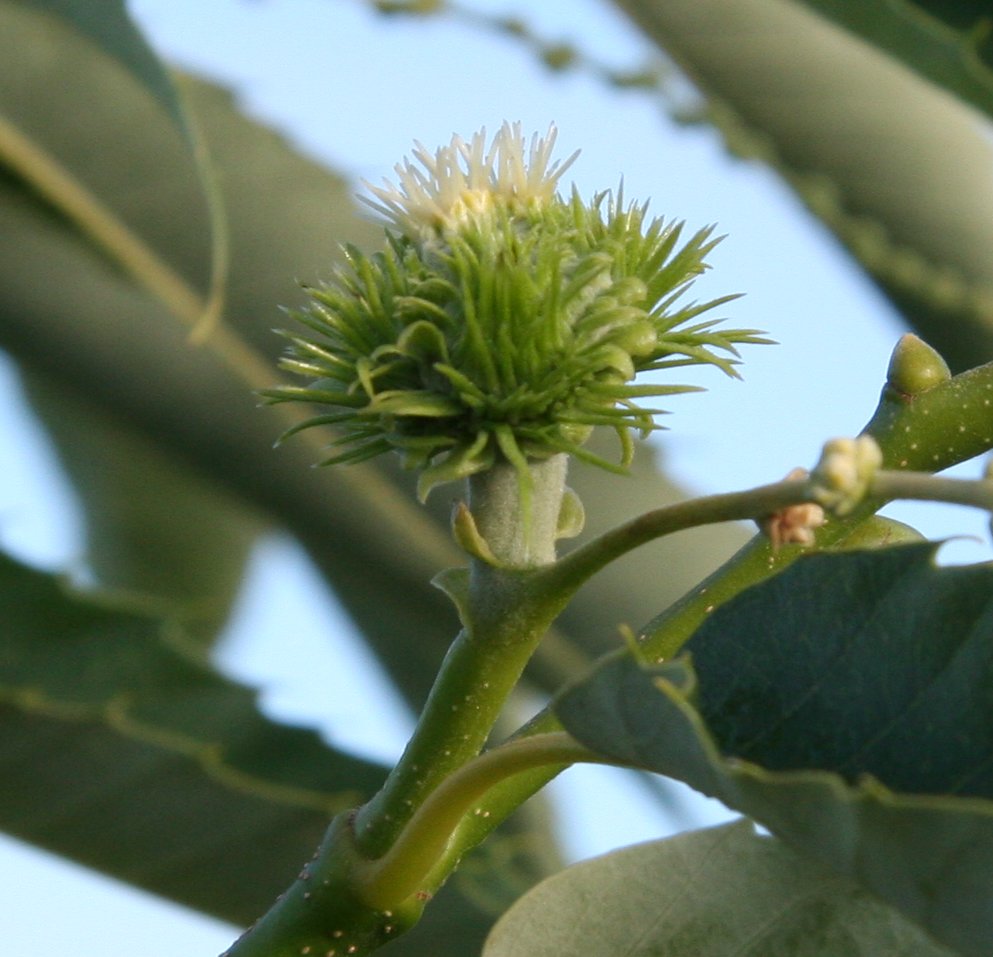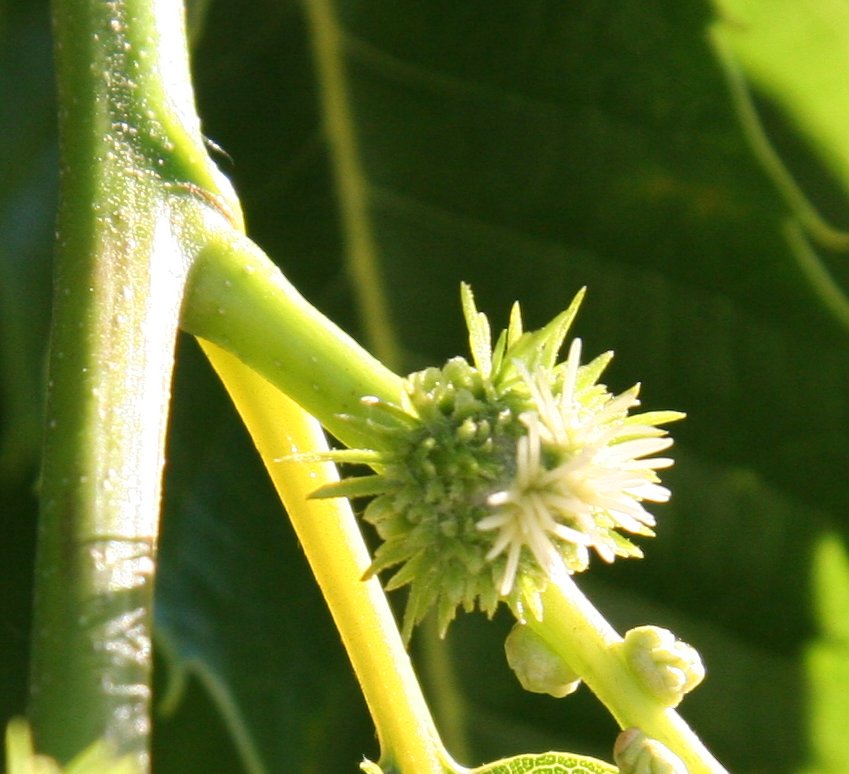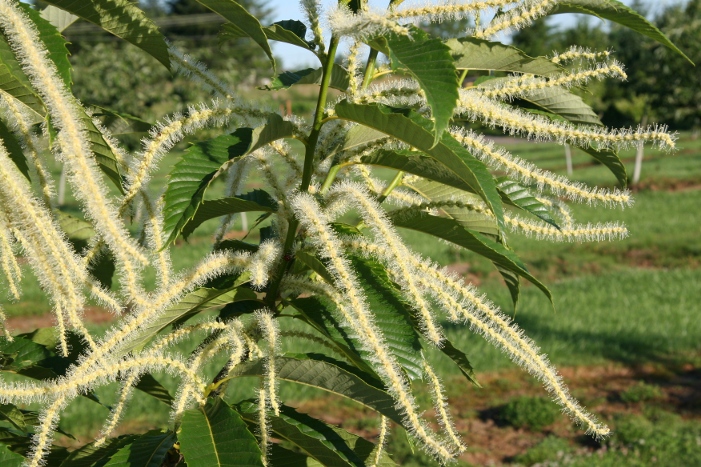 |
||||||||||||||||||||||||
|
| ||||||||||||||||||||||||
|
Chestnuts and Their Dependence on Growing Degree Days
Growing chestnuts in the Western United States used to be an almost sure thing
with a nice crop of nuts coming in from the orchard every fall after the first
4 or 5 years. In 2010 the game changed because of crop failure with chestnut
producers on the West Coast. Is crop failure for chestnut producers predictable
given that crop failure usually happens due to an event or events that cause
the trees to fail to mature a large portion of the crop? Since hind sight
is 20/20 then the year 2010 can provide a good vision of what can cause crop
failure in chestnuts.
The data indicates the warm growing days did not start until some time in July. Reviewing the daily high temps reveals the fact that temps did not get above 70 consistently until after July 5, 2010. Using the data presented, the accumulated GDDs reached the minimum for chestnuts some time in August., but yet the chestnut production was only 10 to 15 percent of expected. Records from the harvest of the chestnuts in the fall of 2010 has entries of some of the chestnuts still being green but not a enough to be considered an anomaly. These facts would present enough evidence for the growing season having enough GDDs to mature the crop. So what happened to the 85 to 90 percent of the crop that was never delivered from the trees? History and good records helps to isolate the possible offending conditions. Other conditions, other than weather, can have an effect on the production levels of chestnut trees. These conditions would not be found uniformly across all chestnut orchards in the Pacific Northwest states, such as poor fertility of the soil or excessive or restricted water supplies to the trees. Disease can cause production loss in rare cases but in the situation of chestnut trees most diseases are long term issues developing over a number of years and the trees also look in poor health. The probability of disease being the offender is not likely for this and other reasons. Since most other conditions, aside from weather conditions, have been set aside as not probable offenders, the issue of the weather is still outstanding. 
Colossal chestnut tree showing female flowers - July, 2010 Since weather is still the most likely offender in causing the chestnut crop failure in the Pacific Northwest in 2010 and the cumulative GDDs were met, the weather information will need to be examined more closely to see if a specific aspect of the weather was an issue. Since water availability was rejected as a potential cause the rainfall for the growing season will not be considered as part of the weather issue. What is left is looking at specific critical periods of the growing season for chestnuts and the associated weather during those critical periods. Lets start with the seasons of the year and summarize the conditions: Winter 2010 . Normal to slightly colder than normal, normal snowfall, normal overall precipitation Spring 2010 . Colder than normal, normal to slightly more than normal precipitation Summer 2010 . Started cooler than normal but quickly fell into normal, normal precipitation Fall 2010 . Normal to slightly warmer than normal, normal precipitation In prior years chestnuts did just fine in normal years. In our season review we see only spring was outside of normal for temps. With this information in hand the details of the spring can be compared with the critical times for chestnuts. There are two basic needs for chestnuts to be able to set and produce chestnuts in the spring time. The first is the development of the male and female flowers. The second is the pollination period. The pollination period is best understood so it is a good starting point. The bloom period for chestnuts in 2010 was July 13 through August 4. The weather was warm and dry, providing the best possible conditions for successful chestnut pollination. During this period the accumulative GDD was 454, or about 23 percent of the seasons total GDDs. During this period every day was above 70 degrees F, with the 70 degrees F possibly being the critical threshold for pollination to be successful. With the weather being normal, delivering warm sunny days during the pollination period, this is not likely going to be the offending period. Left to examine is the spring period, the period where the chestnut trees develop both the male and the female the flowers. 
Bisalta #3 chestnut tree female flower - July, 2010 The development of the flowers are on the current years growth for chestnuts. As the new growth extends from the buds from the prior year.s growth the flowers become visible at the loaf nodes on the new shoot. This is the growth that occurred during the colder than normal weather in 2010 and possibly triggering imperfect female flower development. Records from field observations in 2010 documented very large burrs developed on the trees. At harvest time the contents of the burrs were 90 percent nuts lacking kernels, the other 10 percent of the nuts had a high percentage of poorly developed kernels. Also, the burrs had 3 to 8 blank nuts inside indicating the female flowers were unable to receive the male flower's pollen. Once female flowers start developing (about 190 GDD using base of 50 degrees) on the new branches, the flowers can be harmed by temps below 28 degrees F. Growing degree days is an important part of plant development during the growing season. Most research focused on GDD is around the accumulative GDD a crop needs to successfully mature to harvest. With chestnuts and possibly other crops the GDD has to be delivered across the entire growing season and shortages during critical development periods can possibly result in significant crop failure. Note 1: Growing Degree Days are calculated with the following - Daily GDD = ((Tmax -Tmin) ÷ - Tbase Tmax = the daily maximum air temperature Tmin = the daily minimum air temperature Tbase = the GDD base temperature for the organism being monitored |
|
Contact Information: Farm Location: 6160 Everson Goshen Rd Everson, WA 98247 Ph: (360) 592-3397 Business Offices: Washington Chestnut Company 6160 Everson Goshen Rd. Everson, WA 98247 Ph: (360) 592-3397 |
||||||||||||||||||||||
| © 2006 - 2017 Washington Chestnut Company All Rights Reserved. | ||||||||||||||||||||||||
